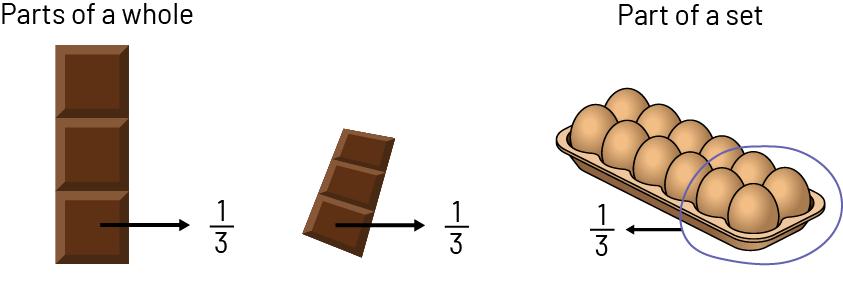B1.6 Use drawings to represent, solve, and compare the results of fair-share problems that involve sharing up to 20 items among 2, 3, 4, 5, 6, 8, and 10 sharers, including problems that result in whole numbers, mixed numbers, and fractional amounts.
Skill: Representing and Solving Fair-Share Problems
In the primary grades, students have the opportunity to explore fractions by partitioning sets of objects (for example, if 3 friends want to share 18 apples equally, each will receive 6 apples) and by examining whole parts separated into equal parts (for example, a rectangle separated into fourths). Partitioning can then serve as a springboard for the study of fractions in the junior grades.
As students continue to build on the principle of sharing, they create connections between the action of sharing, the whole, and parts of the whole. They build understanding of partitioning and develop a sense of the importance of unit fractions. They develop an understanding that the fraction is also used to illustrate a remainder after sharing (for example, if 4 students want to share 5 cupcakes, each gets 1 cupcake and one fourth).
Source: translated from Guide d'enseignement efficace des mathématiques de la 4e à la 6e année, Numération et sens du nombre, Fascicule 2, Fractions, p. 28.
Exploration of Fractions
Baroody and Coslick (1998) emphasize a "meaningful approach" to learning fractions. They advocate that learning fractions follows a progression that moves students from informal, concrete representations to formal, abstract representation. The first two steps of this progression are inherent in this content.
- Partitioning: Any activity that engages students in a meaningful experience of sharing, without explicit reference to terminology or symbolism, provides a concrete foundation for understanding the concept of fractions. Beginning with a common everyday task (for example, partitioning felt pens or coloured pencils for an art project), students can develop the skill of dividing a set of items into equal parts. Later, students may have experiences that involve more elaborate thinking patterns in which they must split a single item (for example, dividing a cardboard box into three equal parts to make a craft).
- Naming Fractions Represented by Models: When they name the fraction associated with a situation, students make a connection between the fraction, the representation used, and the situation, which solidifies their sense of the fraction. This step is important. For example, given a problem in which four friends must share twelve (12) crackers, students are asked to explicitly name the fraction that determines each friend's share of one fourth \(\frac{1}{4}\) of the total crackers.
Source: translated from Guide d'enseignement efficace des mathématiques de la 4e à la 6e année, Numération et sens du nombre, Fascicule 2, Fractions, p. 58.
Knowledge: Mixed Numbers
Learning about fractions usually begins with the use of proper fractions, that is, fractions less than 1. Beginning in Grade 2, students encounter fractions that represent quantities greater than 1 (for example, counting pieces of pie cut into fourths, there are 11 fourths left). Such situations lead students to mixed numbers (for example, \(2\frac{3}{4}\)).
Example
If there are 2 and three fourths pies, the 2 whole pies can be cut or decomposed into fourths, resulting in 8 fourths. Adding the other 3 fourths make a total of 11 fourths, or \(\frac{11}{4}\).

Alternatively, if there are 11 fourths of pie, the fourths can be grouped or recomposed, 4 at a time, to form whole pies. This way, 2 pies can be formed with 8 pieces. This will leave 3 fourths. There are 2 and three fourths pies.

Source: translated from Guide d'enseignement efficace des mathématiques de la 4e à la 6e année, Numération et sens du nombre, Fascicule 2, Fractions, p. 53-54.
Knowledge: Fractions
Understanding the representation of fraction quantities deepens the overall understanding of quantity. It is important to understand that fractions (for example, one half, one third, one fourth) can refer to a part of a whole (a length, an area, or a solid) or to a part of a set, where a collection of items represents the whole. For example, one third of a chocolate bar (part of a whole) represents a quantity of chocolate based on the size of the original bar. However, one third of a dozen eggs (part of a set) represents a quantity based on 12 eggs, which is four eggs.

Source: translated from Guide d’enseignement efficace des mathématiques de la 1re à la 3e année, Numération et sens du nombre, p. 48.
Provide opportunities for students to discover that:
- when the fraction represents an area (area model), the area of each part must be of equal size;
- when fractions are used to describe sets (set model), the objects making up the sets may be different sizes (for example, if the fruit bowl is said to be made up of apples, the other fruit bowl may be made up of grapes that are smaller than the apples);
- the fraction represents a relationship to a whole. It is important for students to know that half of a small amount can be much smaller than one third of a large amount;
- the fraction represents a part of a whole.
Source: translated from Guide d’enseignement efficace des mathématiques de la 1re à la 3e année, Numération et sens du nombre, Document d'appui, p. 30.
Knowledge: Fair-Sharing
A situation where a set is shared or distributed equally among a known number of people or groups.
